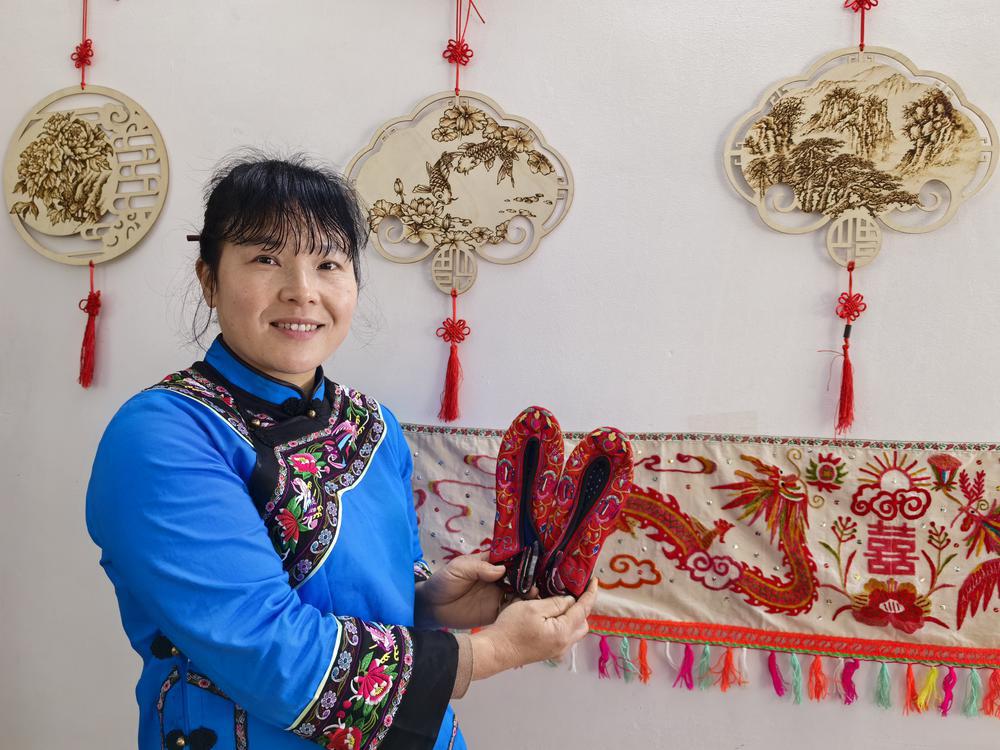
In Shaoguan's Shixing County, the Hakka embroidery tradition stands as a vital part of Hakka culture and an integral component of China's traditional embroidery heritage. Chi Yuefei, a skilled inheritor of Hakka embroidery craftsmanship in the town of Luoba, Shixing County, has passionately dedicated herself to preserving this ancient and intricate art.

Hakka embroidery from Shixing has earned recognition as one of the ninth batch of county-level intangible cultural heritage representative projects. In the village of Dashui, Luoba, our reporter met Chi Yuefei, who was diligently embroidering on her frame. Welcoming the reporter, she enthusiastically introduced her embroidered pieces.
Chi Yuefei's creations include not only embroidered shoes but also bed curtains, door curtains, and even tiger-head hats for children. Each piece exhibits exquisite craftsmanship, featuring patterns of birds, animals, flowers, and insects, reflecting the authentic and imaginative essence of Hakka culture.
Explaining Hakka embroidery, Chi Yuefei highlighted its unique craftsmanship, vibrant colors, and distinctive design style that portray the Hakka people's resilience, collective wisdom, and aspirations for a better life. Apart from conventional embroidery techniques, Hakka embroidery also incorporates a unique style called "chuo chuo xiu" (戳戳绣), or"poking embroidery."
"Poking embroidery is viewed from the reverse side but embroidered from the front, enhancing its vivid colors," Chi Yuefei explained. Having developed a passion for embroidery since childhood, she considers Hakka embroidery a heritage passed down through generations, a heartfelt form of communication.
Despite societal changes discouraging many from practicing embroidery, Chi Yuefei, fearing the loss of Hakka embroidery, took up the needle again. While recognized as an inheritor of Hakka embroidery, she remains unsatisfied, actively participating in heritage exhibitions and learning exchanges to broaden her perspective and enhance her skills. Her ultimate goal is to transform the "fingertip skill" into a "fingertip economy," turning her hobby into a thriving industry.
Source:Yangcheng Evening News
客家刺绣工艺传承人池月妃:祖祖辈辈传下来的手艺,要传承下去
始兴客家刺绣是始兴客家文化的重要组成部分,也是中国传统刺绣文化中不可缺少的一部分。韶关始兴县罗坝镇就有一位始兴客家刺绣工艺的传承人池月妃,因对客家刺绣的热爱,一直坚守传承着客家刺绣这门古老繁复的手艺。
始兴客家刺绣也成功入选了第九批县级非物质文化遗产代表性项目名录。在始兴罗坝都亨的大水村,记者见到了池月妃,她正在绣架上飞针走线,见到记者到来,便热情向记者介绍她的绣品。
池月妃的绣品中除了绣花鞋,还有床帘、门帘、小孩的老虎帽等,每一件绣品都细致精巧,绣品多以飞禽走兽、花草鱼虫为花样,体现着原汁原味的淳朴又极富想象力。
池月妃向记者介绍,客家刺绣以其独特的手工艺,鲜明的色彩和独特的图案风格展现了客家人民的吃苦耐劳、集体智慧以及对美好生活的向往。客家刺绣技艺中除了常见的一些绣法,还有更独特的戳戳绣。
“戳戳绣,看的时候是反面,真正绣的时候是绣正面,这样的话就更能展现出它艳丽的颜色。”池月妃说,她从小就喜欢刺绣,她觉得客家刺绣是客家人祖祖辈辈传下来的手艺,是一种心意的传递。
然而,随着社会的发展进步,许多人不愿意刺绣,她唯恐客家刺绣的失传,又重新拿起了绣花针。虽然被评为客家刺绣非遗传承人,池月妃并不满足现状,多次参加各种非遗展览和交流学习,不断开阔视野,提高技艺,她更希望将“指尖技艺”转化为“指尖经济”,将兴趣爱好变为致富产业。
文、图 | 记者 欧阳志强 通讯员 杨瑞莲 杨兰
译 | 刘佳慧
-
Steel deck pavement of Shenzhen-Zhongshan Link completes
2024-01-12 23:36:04 -
Chaoshan cuisine in Guangdong: Exquisite Chaoshan dishes and artisan spirit
2024-01-12 23:35:16 -
Chinese 'Auspicious Dragon' made in Dongguan to be unveiled overseas
2024-01-11 23:45:32 -
Exploring Guangdong's agricultural history at South China Agricultural Museum
2024-01-11 23:46:43






